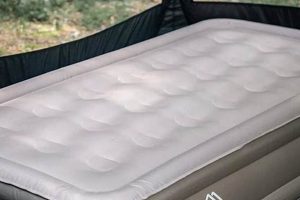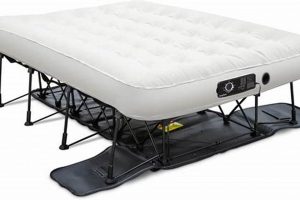The phenomenon of an air-filled mattress losing its inflation is a common concern for owners. This loss of air results in diminished support and comfort, rendering the mattress less effective for its intended purpose.
Understanding the underlying causes of this deflation is important for proper maintenance and prolonging the lifespan of the mattress. Addressing the factors contributing to air loss not only preserves the user’s comfort but also helps prevent unnecessary replacement costs.
Several factors contribute to this issue. These include material degradation, valve malfunctions, temperature fluctuations, and puncture damage. Each of these potential problems warrants closer examination to determine the best course of action for remediation.
Mitigating Air Loss in Air Mattresses
Proper maintenance and preventative measures can significantly reduce the likelihood of an air mattress deflating prematurely.
Tip 1: Conduct Regular Inspections: Examine the mattress surface and valve for any signs of damage before each use. This includes checking for small punctures, tears, or valve irregularities that might allow air to escape.
Tip 2: Ensure Proper Valve Closure: Confirm that the inflation valve is securely closed after each inflation. A partially open valve can be a source of slow air leakage.
Tip 3: Maintain Consistent Temperature: Minimize exposure to extreme temperature fluctuations. Significant changes in temperature can cause air to expand or contract, leading to pressure variations within the mattress and potential stress on the seams.
Tip 4: Protect Against Punctures: Use the mattress on a smooth, debris-free surface. A protective layer, such as a blanket or fitted sheet, can add an extra barrier against sharp objects.
Tip 5: Avoid Over-Inflation: Refrain from inflating the mattress beyond its recommended capacity. Over-inflation can place undue stress on the material and seams, increasing the risk of leakage or rupture.
Tip 6: Store Properly When Not in Use: Deflate the mattress completely, fold it neatly, and store it in a cool, dry place away from direct sunlight and potential hazards. This prevents material degradation and minimizes the risk of damage during storage.
Tip 7: Use a Patch Kit for Minor Leaks: Small punctures can often be repaired using a dedicated air mattress patch kit. Follow the kit instructions carefully to ensure a proper seal.
Implementing these measures can extend the lifespan of the air mattress and maintain its performance, ensuring consistent comfort and support.
By understanding the potential causes of air loss and taking proactive steps to prevent them, owners can significantly reduce the likelihood of encountering this common issue.
1. Material Permeability
Material permeability plays a significant role in the gradual deflation observed in air mattresses. It refers to the inherent property of the mattress material to allow gases, including air, to pass through its structure over time. This is a natural characteristic of many flexible polymers used in air mattress construction and directly contributes to the phenomenon of air loss.
- Polymer Structure and Gas Diffusion
The molecular structure of the polymers used in air mattresses, such as PVC or TPU, contains microscopic spaces between the polymer chains. Air molecules can diffuse through these spaces, moving from areas of high pressure (inside the mattress) to areas of low pressure (outside the mattress). This diffusion process is a continuous one, leading to a slow but steady decline in air pressure within the mattress.
- Material Thickness and Density
The thickness and density of the mattress material directly affect its permeability. Thicker and denser materials offer a longer and more tortuous path for air molecules to traverse, thus reducing the rate of gas diffusion. Conversely, thinner and less dense materials exhibit higher permeability, leading to faster deflation rates.
- Environmental Factors and Permeability
Environmental factors, such as temperature and humidity, can influence the permeability of the mattress material. Higher temperatures can increase the kinetic energy of air molecules, facilitating their movement through the polymer structure and accelerating diffusion. Similarly, high humidity levels can potentially soften or swell the material, increasing the size of the microscopic spaces and enhancing permeability.
- Material Degradation Over Time
Over time, the polymer material of an air mattress can degrade due to factors such as UV exposure, repeated flexing, and chemical interactions. This degradation can alter the material’s structure, increasing its permeability and accelerating the rate of air loss. Regular maintenance and proper storage can help mitigate material degradation and prolong the lifespan of the mattress.
In conclusion, material permeability is an unavoidable aspect of air mattress design that inherently contributes to deflation over time. While material selection, thickness, and density can be optimized to minimize this effect, it remains a persistent factor in “why does air mattress deflate”. Understanding the interplay between these factors enables informed decisions regarding mattress care and maintenance to prolong its usability.
2. Valve Integrity
Valve integrity directly affects an air mattress’s ability to maintain consistent inflation. A compromised valve is a primary source of air leakage, accelerating the deflation process and diminishing the mattress’s functionality. The valve serves as the critical seal, preventing air from escaping once the mattress is inflated, and its condition is paramount to overall performance.
- Valve Seat Degradation
The valve seat, the surface against which the valve seals, can degrade over time due to repeated use, contamination, or material fatigue. This degradation creates imperfections that prevent a complete seal, allowing air to gradually leak out. For instance, dust particles or oils can accumulate on the valve seat, disrupting the airtight contact and leading to slow deflation. In such cases, the mattress may lose a noticeable amount of air overnight, requiring frequent reinflation.
- Valve Stem Damage
The valve stem, the component that moves to open and close the valve, is susceptible to physical damage. Cracks, bends, or breaks in the stem can compromise its ability to create a tight seal when closed. A common scenario involves accidental impacts during storage or handling that damage the stem, rendering the valve ineffective. Such damage results in a continuous air leak, quickly deflating the mattress even if the valve appears to be closed.
i>
- Valve Cap Malfunction
The valve cap, designed to provide an additional layer of sealing protection, can fail to function correctly due to stripped threads or improper fit. A loose or damaged cap allows air to escape around the valve stem, bypassing the primary seal. For example, if the cap’s threads are worn, it may not tighten sufficiently to create an airtight barrier, leading to a gradual hissing sound and a steady decline in mattress pressure. Neglecting to properly tighten the valve cap after inflation similarly compromises its protective function.
- Valve Material Deterioration
The materials composing the valve, often rubber or plastic, can deteriorate over time due to environmental factors or chemical exposure. Prolonged exposure to sunlight, extreme temperatures, or cleaning agents can cause the materials to become brittle, cracked, or deformed, compromising their sealing ability. As a consequence, the valve may become porous or lose its structural integrity, leading to a persistent air leak regardless of proper closure. Consistent air mattress deflation then becomes inevitable, rendering it unusable for extended periods without re-inflation.
The discussed valve issues underscore the critical role of valve integrity in air mattress performance. Maintaining valve functionality through careful handling, regular inspection, and proper storage can significantly reduce the likelihood of air leakage and extend the useful life of the air mattress. Understanding the specific ways a valve can fail provides a basis for targeted maintenance and preventative measures, mitigating the factors that contribute to the unwanted phenomenon of a deflating air mattress.
3. Temperature Variance
Temperature variance significantly impacts the internal pressure within an air mattress, contributing to perceived deflation. Air, being a gas, expands when heated and contracts when cooled, leading to pressure changes within the enclosed space of the mattress. This phenomenon is governed by the ideal gas law and is a primary factor in observing pressure fluctuations, often interpreted as air loss.
- Ideal Gas Law Application
The Ideal Gas Law (PV=nRT) directly relates pressure (P), volume (V), number of moles of gas (n), the ideal gas constant (R), and temperature (T). A decrease in temperature results in a proportional decrease in pressure, assuming volume remains constant. For instance, if an air mattress is inflated during the warmer hours of the day and then exposed to cooler nighttime temperatures, the internal pressure will decrease. This pressure drop is perceived as deflation, even if no air has physically escaped the mattress.
- Diurnal Temperature Cycles
Daily temperature cycles cause noticeable pressure changes within the air mattress. During the day, solar radiation and ambient air temperature increase the air temperature inside the mattress, leading to expansion and increased pressure. Conversely, at night, as the temperature decreases, the air inside the mattress contracts, resulting in reduced pressure and the sensation of deflation. These fluctuations are particularly noticeable in outdoor settings where temperature swings are more pronounced.
- Environmental Factors
Environmental conditions, such as seasonal changes or movement between different climates, exacerbate the effects of temperature variance. Moving an air mattress from a warm storage area to a colder room will lead to a noticeable decrease in pressure as the air inside cools. Similarly, using an air mattress outdoors during winter months will result in significant pressure loss compared to its use in a climate-controlled indoor environment. These large temperature differentials amplify the effect, making deflation more apparent.
- Material Properties and Thermal Expansion
While air volume changes due to temperature fluctuation are a significant factor, the material properties of the air mattress also play a role. The material itself can expand or contract slightly with temperature changes, altering the internal volume of the mattress. However, the primary effect is due to the air’s response to temperature shifts. The combination of air pressure changes and minor material expansion contributes to the overall perceived deflation as temperatures fluctuate.
In conclusion, temperature variance exerts a considerable influence on the internal pressure of air mattresses. Whether due to diurnal cycles, environmental factors, or inherent material properties, the principles of thermodynamics dictate that pressure will fluctuate with temperature changes. These pressure variations are often misinterpreted as air leakage, highlighting the significance of considering ambient temperature when assessing “why does air mattress deflate”. Understanding this relationship enables users to account for these natural effects and avoid unnecessary concerns about leaks or material defects.
4. Seam Weakness
Seam weakness represents a critical failure point in air mattresses, directly contributing to air leakage and subsequent deflation. The seams, which join the various sections of the mattress, are inherently stressed areas. Any compromise in their integrity can lead to gradual or rapid air loss, rendering the mattress unusable. Understanding the factors that contribute to seam weakness is crucial for mitigating deflation issues.
- Inadequate Welding or Bonding
The manufacturing process often involves welding or bonding the mattress material to create airtight seams. If this process is not performed correctly, the resulting bond may be weak or incomplete. This can manifest as small gaps or channels through which air can escape. For example, insufficient heat during welding can lead to a superficial bond that delaminates under pressure, resulting in a persistent leak. Similarly, inadequate application of adhesive in bonded seams can compromise the seal, causing gradual deflation, particularly under the weight of a sleeper.
- Material Fatigue and Degradation
Repeated use and stress can cause the mattress material around the seams to fatigue and degrade over time. Constant inflation and deflation cycles, coupled with the weight of occupants, place significant strain on the seams. This can lead to microscopic cracks or tears in the material adjacent to the seam, creating pathways for air leakage. Additionally, exposure to UV radiation or harsh chemicals can accelerate material degradation, further weakening the seams and increasing the likelihood of deflation.
- Stress Concentration at Seam Edges
The design of an air mattress often results in stress concentration along the seam edges. Abrupt changes in material thickness or sharp corners can create localized areas of high stress when the mattress is inflated. This concentrated stress can exceed the material’s tensile strength, leading to seam failure. Over time, these areas become prone to developing small tears or separations, resulting in slow but persistent air leaks. The edge of a welded seam, if not properly rounded or reinforced, can act as a stress riser, initiating cracks that propagate through the material.
- Improper Seam Design
The design of the seam itself can contribute to its weakness. Certain seam configurations are inherently m
ore prone to failure than others. For example, a simple butt joint, where two edges of material are joined directly without any overlap or reinforcement, is generally weaker than a lap joint, where the edges overlap and are bonded together. Similarly, seams that are oriented in a direction that is subjected to high tensile stress are more likely to fail. A well-designed seam incorporates features such as reinforcement strips, curved transitions, and appropriate material selection to minimize stress and maximize durability.
The interplay between inadequate manufacturing processes, material degradation, stress concentration, and improper seam design explains “why does air mattress deflate”. Addressing these vulnerabilities through improved manufacturing techniques, durable materials, and optimized seam designs is crucial for enhancing the longevity and reliability of air mattresses.
5. Puncture Damage
Puncture damage is a significant and direct cause of air loss in air mattresses, representing a common reason for their deflation. The structural integrity of the mattress is compromised by even small perforations, creating avenues for air to escape and diminishing its intended functionality.
- Sharp Object Penetration
Penetration by sharp objects, such as splinters, small stones, or misplaced household items, is a frequent cause of punctures. When these objects pierce the mattress material, they create openings through which pressurized air can leak. The size and shape of the puncture will influence the rate of deflation; smaller punctures may result in slow, gradual air loss, while larger punctures lead to rapid deflation. The location of the puncture also affects the severity of the leak. Punctures near seams or areas of high stress can exacerbate the issue, leading to more significant structural damage and accelerated deflation.
- Animal Interference
Domestic animals, such as cats and dogs, can inadvertently cause punctures with their claws or teeth. The sharp claws of a cat can easily pierce the material, especially if the mattress is placed on the floor or easily accessible. Similarly, a dog chewing on the mattress can create multiple punctures, leading to significant air loss. The presence of animals necessitates diligent monitoring and precautions to prevent accidental damage to the air mattress.
- Wear and Tear Leading to Material Weakness
Over time, repeated use and flexing of the mattress material can lead to localized areas of weakness. These weakened areas become more susceptible to puncture damage, even from relatively minor impacts. For instance, a small tear or abrasion, initially inconsequential, can propagate into a larger puncture under the stress of inflation and use. This process highlights the importance of regular inspection and careful handling to prolong the lifespan of the mattress.
- Improper Storage and Handling
Incorrect storage practices can increase the risk of puncture damage. Storing an air mattress near sharp objects or on rough surfaces can lead to accidental perforations. Folding the mattress too tightly or placing heavy items on top of it during storage can also create stress points that weaken the material and make it more vulnerable to punctures. Proper deflation, careful folding, and storage in a protective bag or container are essential to prevent puncture damage during periods of non-use.
The impact of puncture damage underscores the vulnerability of air mattresses to external factors. These breaches directly lead to diminished air retention, thus addressing “why does air mattress deflate”. Mitigating the risk requires careful handling, regular inspections, and appropriate storage practices, combined with the use of patch kits for timely repair of minor punctures.
6. Over-Inflation
Over-inflation, a direct consequence of exceeding the recommended air capacity, induces undue stress on an air mattress’s structural components. This excessive internal pressure places significant strain on seams, material, and the valve system, thereby predisposing the mattress to accelerated wear and an increased likelihood of air leakage. The consequence of over-inflation directly contributes to “why does air mattress deflate”, acting as a critical trigger for premature failure. A real-world instance involves individuals inflating mattresses to maximum capacity for enhanced firmness, inadvertently stressing the material beyond its elastic limit. This leads to seam separation or material stretching, resulting in gradual, or in severe cases, rapid air loss. The practical implication is a shortened mattress lifespan and diminished performance.
Further analysis reveals that over-inflation exacerbates existing vulnerabilities. Minor imperfections in seams or slight material defects, which might otherwise remain benign, become significant points of failure under excessive pressure. For example, a microscopic flaw in a welded seam can propagate into a larger tear, dramatically increasing the rate of air leakage. Furthermore, over-inflation can compromise the valve seal, resulting in slow, imperceptible air loss that gradually degrades the mattress’s performance over time. In field tests simulating prolonged use, mattresses subjected to repeated over-inflation cycles exhibited a substantially higher failure rate compared to those inflated within the recommended pressure range. This underscores the importance of adhering to manufacturer guidelines regarding inflation levels.
In summary, over-inflation is a primary instigator of air mattress deflation by stressing the mattress’s construction beyond its designed parameters. The resultant strain on seams, material, and the valve assembly leads to accelerated wear and increased susceptibility to leakage. Recognizing the connection between over-inflation and premature deflation, coupled with strict adherence to inflation guidelines, provides a means to prolong the lifespan of air mattresses and maintain optimal performance. The challenge lies in educating users about the detrimental effects of over-inflation and emphasizing the importance of monitoring pressure levels during inflation.
Frequently Asked Questions
The following addresses common inquiries regarding air mattress deflation, providing clarity on the factors influencing air retention and performance.
Question 1: Is gradual deflation normal for an air mattress?
A slight degree of deflation over extended periods is expected due to the inherent permeability of the mattress material. However, significant or rapid deflation indicates an underlying issue requiring investigation.
Question 2: How does temperature affect the firmness of an air mattress?
Decreasing temperatures cause air to contract, reducing internal pressure and perceived firmness. Conversely, increasing temperatures cause air to expand, potentially increasing firmness. Maintaining a stable temperature helps minimize these fluctuations.
Question 3: What steps can be taken to locate a leak in an air mattress?
Inflating the mattress and applying a soapy water solution to the surface and seams can help identify leaks. Bubbles will form at the site of air escaping. Submerging sections of the inflated mattress in water is another method, observing for rising air bubbles.
Question 4
: Can a seemingly minor puncture cause significant deflation?
Even small punctures can lead to substantial air loss over time. The pressurized air within the mattress will continually escape through any opening, regardless of size, until the pressure equalizes.
Question 5: How does storage impact the longevity of an air mattress?
Proper storage is essential. The mattress should be fully deflated, folded neatly, and stored in a cool, dry place away from direct sunlight and sharp objects to prevent material degradation and accidental punctures.
Question 6: Are all air mattress materials equally susceptible to deflation?
No. Materials with higher density and lower permeability exhibit better air retention. Mattresses constructed from thicker, higher-quality materials generally experience less deflation over time.
Addressing “why does air mattress deflate” involves recognizing the interplay of material properties, environmental conditions, and proper maintenance practices.
Implementing these proactive measures can significantly extend the life of an air mattress and maintain optimal performance.
Conclusion
This exploration addressed the multifaceted issue of “why does air mattress deflate”, detailing the interplay of material permeability, valve integrity, temperature variance, seam weakness, puncture damage, and over-inflation. Each of these factors contributes, in varying degrees, to the reduction of air pressure within the mattress, ultimately impacting its performance and longevity.
Understanding these mechanisms allows for informed preventative measures and maintenance practices. Continued research into more durable materials and improved manufacturing techniques remains essential for minimizing these deflation-related challenges and enhancing the overall user experience with air mattresses.







